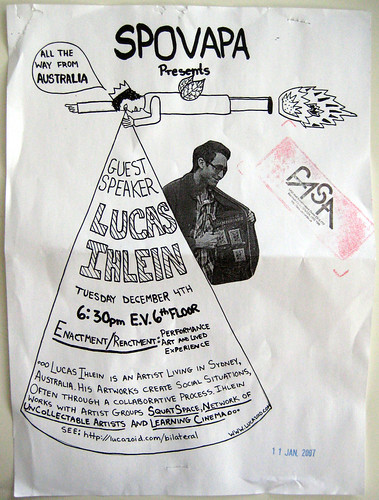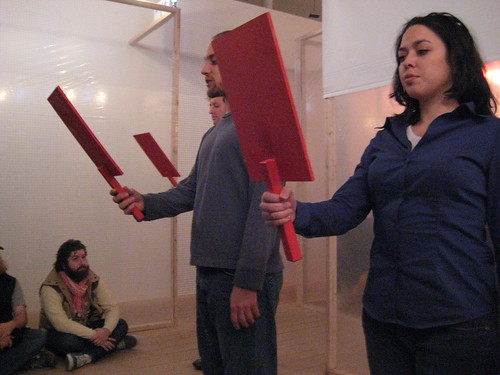It seems that Sydney will host a "re-enactment" of a historical battle between convicts and soldiers:
"It was on March 4, 1804, that several hundred convicts broke out of the Castle Hill government farm, with plans to storm the garrison at Parramatta and march on Sydney, where boats would be seized and a daring escape made.
Instead, after 24 hours of confusion and conspiracy, the escapees were confronted by Governor King's soldiers and the militia on a site north of what is now the new suburb of Kellyville Ridge. Fifteen convicts were shot dead, their leaders captured and executed or exiled." [from Sydney Morning Herald 5 Feb 2004]
It could be an interesting event, performance-wise, if it stays away from nostalgic cliches. Jane and I drove through a small town near the SA-Victoria border in November 2002, which was having a "dedication to the pioneers" day. It was nauseating – men in breeches and women and children in bonnets milling around in makeshift tent buildings, while a pompous country town mayor pulled back a homemade curtain to reveal a plaque dedicated to the hardworking ancestors of the town, who had survived through gruelling times, and gave us what we have today. Or some other crap.
No mention of displaced/massacred indigenous inhabitants.
Neither are they mentioned in the spiel about the Battle of Vinegar Hill. The event's official website only offers:
"Commemorating this particular event in Australian history is not to pay tribute to a Battle, or to revive the sectarian and authoritarian issues that led to the rebellion almost 200 years ago. The survivors of the battle from both camps, and their children after them, were the pioneers of this nation. Few of them had a choice in whether or not they came to this isolated land so far from all they knew. A great many on both sides stayed and became worthy citizens of a new country where differences could be settled without the bloodshed suffered at Vinegar Hill."
It's hard not to be cynical about such a statement. No mention is made of some of Australia's most famous current prisoners, who certainly have shed blood by sewing their lips together.
What is interesting, however, is the historical background to the "battle" –
"Among the embezzlers, forgers, petty thieves, sheep stealers and house breakers transported to the colony, were men whose crimes were purely political. The resentment of these political prisoners knew no bounds. Many of the Irish convicts were infuriated by the lack of official records and the resulting injustice and confusion over the lengths of their sentences. Realising the impossibility of returning to Ireland, the dissidents created a state of constant unrest in the new community. Cropping their hair in the style of the French revolutionaries, they formed secret leagues and held clandestine meetings to plan their escape. In desperation, they attempted to lay siege to the colony and demanded to be taken home to Ireland." [from a book by Lynette Ramsey Silver]
The "botched mini-rebellion" [as Silver describes it] got its name from Vinegar Hill, Wexford, in Ireland, where an "insurgence" of a much larger scale took part in 1798. More information about the Irish Vinegar Hill is available from the Irish National 1798 visitors centre website. My knowledge of Irish history is scanty, so any insights on this appreciated.
I haven't been able to locate a source as to whether any of the Sydney convicts who participated in the Sydney insurgence were also involved in the Irish one. It's a juicy thread, because in a way, the 1804 battle was already "referring" to another historical event from six years previous.
I'd also especially like to understand better this line from the visitors centre site: "The award winning National 1798 Centre offers a fascinating insight into the birth of modern democracy in Ireland."
How is this statement related to the comment by the Sydney re-enactment committee: "As part of the 200th Anniversary celebrations of the Battle of Vinegar Hill in March 2004, the combined Councils of Baulkham Hills, Blacktown, Hawkesbury, Holroyd, and Parramatta will be organising a Descendants Day to recognise the contribution that those involved in the Battle made to justice, freedom and the right to self determination in Australia."
One final question – the Sydney re-enactment of Vinegar Hill is being carried out by "several Groups of re-enactors who are mostly from the Napoleonic Period (1790's to 1815) and already have appropriate costume". What, or who, exactly, are these "re-enactors"?
[postscript – there is a review from the Sydney Morning Herald, (8 March 2004) here.]


